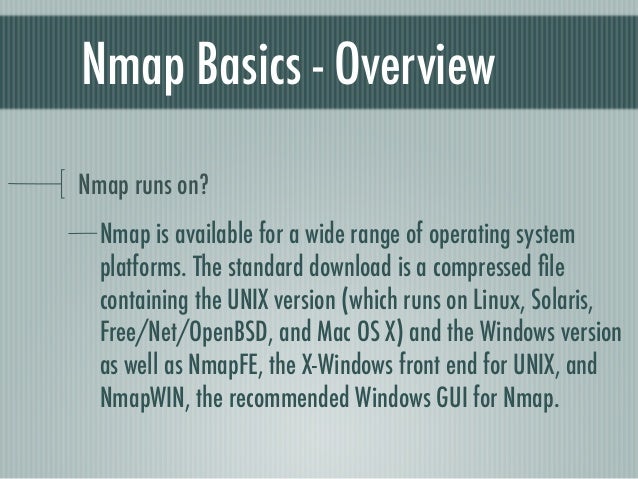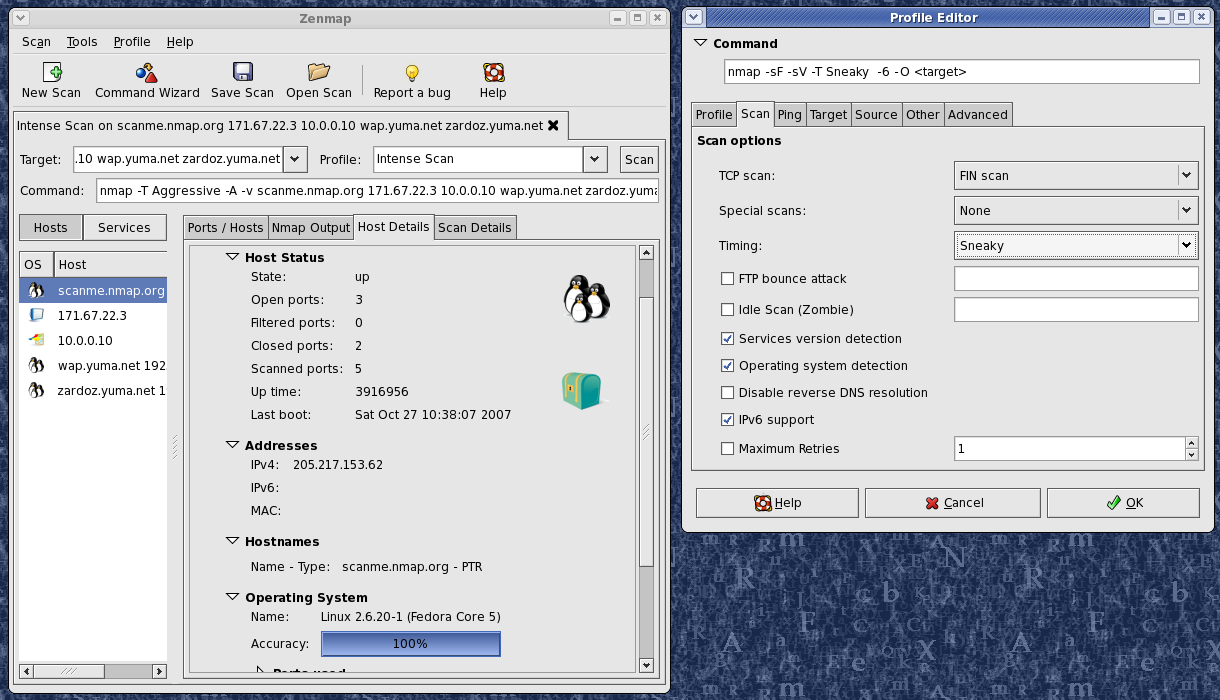Nmap has supported Mac OS X since 2001, and our support has only improved over time. While Mac users can compile Nmap themselves, we also offer an executable installer. Nmap makes use of Jhbuild and gtk-mac-bundler which are used to build other projects for Mac OS X, such as OpenSSL, libapr, libsvn... Nmap is also available through systems such as MacPorts and Fink which package Unix software for Mac OS X.
There isn’t much more to arp. You can run arp -a -i en0 to only get reports from your network interface en0, but that’s all. The most powerful tool for scanning your local network on macOS is nmap. Arp is also useful for running a ping sweep across the network. Ipconfig can report results for a specific interface but is more useful for reporting interface information than. Nmap 7.80 for Mac is available as a free download on our software library. The latest installer takes up 20 MB on disk. The app's installation file is commonly found as nmap-6.47.dmg. The most popular version among the program users is 6.4.
The easiest way to install Nmap and Zenmap on Mac OS X is to useour installer. TheMac OS X section ofthe Nmap download page provides a file namednmap-, where<version>.dmg<version> is the version number of the mostrecent release. The.dmgfile is known as a“disk image”. Installation instructions follow:

Download the file
nmap-.Double-click the icon to open it. (Depending on how you downloaded thefile, it may be opened automatically.)<version>.dmgThe contents of the disk image will be displayed. One ofthe files will be a Mac meta-package file named
nmap-.Open it to start the installer.<version>.mpkgOn OS X 10.8 and later, you may see a dialog likeFigure 2.2.
Figure 2.2. Apple Gatekeeper block screen
If this happens, it is necessary to right-click or control-click on the.mpkgand select “Open”,as shown inFigure 2.3.Figure 2.3. Apple Gatekeeper Open menu
A dialog similar to the first will appear, this time having an“Open” button (shown inFigure 2.4).Click the button to continue.Figure 2.4. Apple Gatekeeper Open screen
Follow the instructions in theinstaller. You will be asked for your password since Nmap installs in a system directory.
Once the installer is finished, eject the disk image bycontrol-clicking on its icon and selecting“Eject”. The disk image may now be placed inthe trash.
See the instructions in the section called “Executing Nmap on Mac OS X” forhelp on running Nmap and Zenmap after they are installed.
The programs installed by the installer will run on Intel Mac OS X 10.5(Leopard) or later. Users of earlier versions will have to compile fromsource or use a third-party package. Instructions for PowerPC (PPC) Mac systems (which Apple ceased selling in 2006) are available on our wiki.
Compiling Nmap from source on Mac OS X is no more difficult thanon other platforms once a proper build environment is in place.
Compiling Nmap on Mac OS X requiresXcode,Apple's developer tools that include GCC and the rest of the usual buildsystem. Xcode is not installed by default, but can be downloaded free ofcharge from the Mac AppStore. After installing Xcode, open“Preferences”, select the“Downloads” tab, and click the“Install” next to “Command LineTools”.
Xcode installations don't always include the command line tools. You can install them by opening Xcode from the Applications folder, opening Preferencechoosing the Download header icon and clicking the Install button next to “Command Line Tools”.
Once you have installed Xcode and the command-line tools, follow the compilation instructions found in the section called “Linux/Unix Compilation and Installation from Source Code”. Note that on some older versions of Mac OS X, you may have to replace the command ./configure with ./configure CPP=/usr/bin/cpp. Also, on some newer Mac OS X versions, the libpcap version of the library provided by Apple may be too old. You may have to configure Nmap with the command ./configure --with-libpcap=included in order to use the compatible version included in Nmap, or you should update the libpcap installed on your machine.
Zenmap depends on some external libraries that do not come withMac OS X, including GTK+ and PyGTK. These libraries have many dependenciesof their own. A convenient way to install all of them is to use athird-party packaging system as described inSection . Once the dependencies areinstalled, follow the instructions in the section called “Linux/Unix Compilation and Installation from Source Code” toinstall Zenmap as usual.
Another option for installing Nmap is to use a systemwhich packages Unix software for Mac OS X. The two discussed here areFink andMacPorts. See therespective projects' web sites for how to install the packagemanagers.
To install using Fink, run the command fink installnmap. Nmap will be installed as/sw/bin/nmap. To uninstall use the commandfink remove nmap.
To install using MacPorts, run sudo portinstall nmap. Nmap will be installed as/opt/local/bin/nmap. To uninstall, runsudo port uninstall nmap.
These systems install the nmapexecutable outside the global PATH. To enable Zenmap tofind it, set the nmap_command_path variable inzenmap.conf to /sw/bin/nmap or/opt/local/bin/nmap as described inthe section called “The nmap Executable”.
The terminal emulator in Mac OS X is calledTerminal, and is located in the directory/Applications/Utilities. Open it and aterminal window appears. This is where you will type your commands.
By default the root user is disabled on Mac OS X. To run a scan withroot privileges prefix the command name withsudo,asin sudo nmap -sS <target>.You will be asked for a password, which is just your normal loginpassword. Only users with administrator privileges can do this.
Zenmap requires the X11 application tobe installed. If it was not installed by default it may be available asan optional install on the Mac OS X installation discs.
When Zenmap is started, a dialog is displayed requesting that youtype your password. Users withadministrator privilegesmay enter theirpassword to allow Zenmap to run as the root user and run more advancedscans. To run Zenmap in unprivileged mode, select the“Cancel” button on this authentication dialog.
| ||||||||||||||||
Downloading Nmap
Nmap and Zenmap (the graphical front end) are available inseveral versions and formats. Recent source releases and binarypackages are described below. Older version (and sometimes newer testreleases) are available from the dist directory(and really old ones are in dist-old).For the moresecurity-paranoid (smart) users, GPG detached signatures and SHA-1hashes for each release are available in the sigsdirectory (verification instructions). Before downloading, be sure to read the relevant sections for your platform from the Nmap Install Guide. The mostimportant changes (features, bugfixes, etc) in each Nmap version aredescribed in the Changelog. Using Nmap is covered in the Reference Guide, and don't forget to readthe other available documentation, particularly the new book Nmap Network Scanning!
Nmap users are encouraged to subscribe to the Nmap-hackersmailing list. It is a low volume (7 posts in 2015), moderated listfor the most important announcements about Nmap, Insecure.org, andrelated projects. You can join the 128,953 current subscribers (as ofSeptember 2017) by submitting your email address here:
You can also get updates from our Facebook and Twitter pages.
Nmap is distributed with source code under custom license terms similar to (and derived from) the GNUGeneral Public License, as noted in the copyright page.

Microsoft Windows binaries
Please readthe Windows section of theInstall Guide for limitations and installation instructions for theWindows version of Nmap. You can choosefrom a self-installer (includes dependencies and also the Zenmap GUI)or the much smaller command-line zip file version. We support Nmap on Windows 7 and newer, as well as Windows Server 2008 and newer. We also maintain a guide for userswho must run Nmap on earlier Windows releases..

Note: The version of Npcap included in our installers may not always be the latest version. If you experience problems or just want the latest and greatest version, download and install the latest Npcap release.
The Nmap executable Windows installer can handle Npcapinstallation, registry performance tweaks, and decompressing theexecutables and data files into your preferred location. It also includes the Zenmap graphical frontend. Skip all thecomplexity of the Windows zip files with a self-installer:
Latest stable release self-installer: nmap-7.91-setup.exe
Latest Npcap release self-installer: npcap-1.10.exe
We have written post-install usageinstructions. Please notify usif you encounter any problems or have suggestions for theinstaller.
For those who prefer the command-line zip files (Installation Instructions; UsageInstructions), they are still available. The Zenmap graphicalinterface is not included with these, so you need to runnmap.exe from a DOS/command window. Oryou can download and install a superior command shell such as thoseincluded with the free Cygwin system.Also, you need to run the Npcapand Microsoft Visual C++ 2013 Redistributable Packageinstallers which are included in the zip file. The main advantage is that these zip files are a fraction of the size of the executable installer:
Latest stable command-line zipfile:nmap-7.91-win32.zip
Linux RPM Source and Binaries
Many popular Linux distributions (Redhat, Mandrake, Suse, etc) usethe RPM package management system forquick and easy binary package installation. We havewritten a detailed guide toinstalling our RPM packages, though these simple commands usually dothe trick:You can also download and install the RPMs yourself:
Latest stable release:
x86-64 (64-bit Linux)Nmap RPM: nmap-7.91-1.x86_64.rpm
x86-64 (64-bit Linux)Ncat RPM: ncat-7.91-1.x86_64.rpm
x86-64 (64-bit Linux)Nping RPM: nping-0.7.91-1.x86_64.rpm
Optional Zenmap GUI (all platforms): zenmap-7.91-1.noarch.rpm
Source RPM (includes Nmap, Zenmap, Ncat, and Nping): nmap-7.91-1.src.rpm
Mac OS X Binaries
Nmap binaries for Mac OS X (Intel x86) are distributed as a disk image filecontaining an installer. The installer allows installing Nmap, Zenmap,Ncat, and Ndiff. The programs have been tested on Intel computersrunning Mac OS X 10.8 and later. See theMac OS X Nmap installpage for more details. Users of PowerPC (PPC) Mac machines, which Apple ceased selling in 2006, should see this page instead for support information.
Latest stable release installer: nmap-7.91.dmg
Source Code Distribution
This is the traditional compile-it-yourself format. The Nmaptarball compiles under Linux, Mac OS X, Windows, and many UNIXplatforms (Solaris, Free/Net/OpenBSD, etc.) It includes Zenmap, theGUI frontend.
Download Nmap For Macos 10.13
Detailed Linux/BSD/Solaris compilation instructions and options are provided here, though this usually does the trick:
Most Windows users install with our Windows executable installer, but we also provide Windows source code compilation instructions.
Most Mac OS X users install with our Mac installer, but we also provide Mac OS X source code compilation instructions.
If you are compiling Nmap anyway, you might prefer to get the very latest code from our SVN source code repository rather than downloading a tarball here.
Latest stable Nmap release tarball: nmap-7.91.tar.bz2 (or gzip compressed)
Other Operating Systems
Download Nmap For Macos Installer
Many other operating systems support Nmap so well that I have no needto create and distribute binary packages myself. You can choose touse the packages below, or compile the sourcedistribution, which is often newer. We have created installation pages for the following platforms:
Linux (all distributions)
Microsoft Windows
Mac OS X
FreeBSD, OpenBSD, and NetBSD
Sun Solaris
Amiga, HP-UX, and Other Platforms
Download Nmap For Macos Linux
Nmap Site Navigation
Nmap Download Mac Os
| Intro | Reference Guide | Book | Install Guide |
| Download | Changelog | Zenmap GUI | Docs |
| Bug Reports | OS Detection | Propaganda | Related Projects |
| In the Movies | In the News | ||